
Musandam
Location | Geology | Way of Life | Round the bend | Fishing | Traders from Iran | Diving | Getting there | References
The "Norway" of Arabia
The
Musandam Peninsula is the northernmost part of Oman jutting out into the
Strait of Hormuz at the entrance to the Persian Gulf. The province, or governorate of Musandam as it is officially known, is separated from the rest of Oman by various of the United Arab Emirates - Ras al Khaimah and Fujairah. Musandam more or less begins where the mountains rise from the plains of Ras al Khaimah.
The mountains have isolated communities for centuries. Coastal villages can be reached only by boat rather than by road. Pockets of flat land support meagre agriculture. The population of approximately 29,000 is concentrated in the capital, Khasab (18,000 in 2004) in the north and Dibba (5,500) on the east coast. Fishing is the principal economic activity supported by employment in government jobs. Tourism could be a major earner. Traders from Iran boost the port trade of Khasab.
At its nearest point Musandam is just 55 km from Iran across the strait. See the satellite image which will open in a separate window. The file size is 72.5 K and takes up to 30 seconds to download fully at 28.8K.
In 2000, we flew from Muscat to Khasab, the main town, in Oman Air's twin engine aircraft. A new, international airport opened at Khasab late in 2003, which can take larger aircraft flying from Dubai.
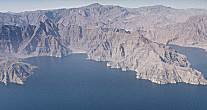 |
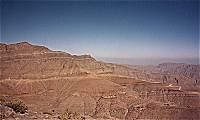
|
|
| The Musandam peninsula. The rocks rise straight out of the sea. | View south from Jabal Harim, over 1,500 m high. |
Geology
The mountains rise straight out of the sea giving rise to the fiord-like appearance of the coast, superbly evident from the air.
Rocks of the Hajar supergroup in the north appear to be flat-lying but are actually folded in a north-south trending anticline. Thinly-bedded yellowish-orange dolomitic limestones and mudstones indicating a near-shore environment progress upwards into highly fossiliferous shelf limestones. Shell fragments, brachiopods and micro-fossils in limestone indicate continental shelf conditions. These limestones were deposited from the early Jurassic to the Cretaceous period and are reckoned to be older than 65Ma.
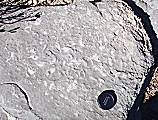 |
 |
|
| Shelly fossils in limestone at 1,500m on Jabal Harim. | View north down Wadi Khasab. |
Way of Life
Occasional flat ledges of land have been terraced for
small-scale agriculture. Low walls are built round the cultivated areas
to trap surface run-off. Silt settles from the water flattening the
profile of the land and adding to soil. Three dams protect Khasab town
from flash floods.
Stone houses, several centuries old, can still be seen hugging the mountain sides in some of the wadis. Rock art made by pecking boulders with a stone implement, can be seen in Wadi Qida.
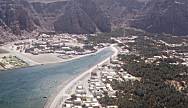
|
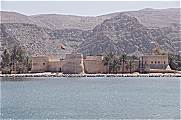 |
|
| View of Khasab from the air | Khasab fort lies on the shore |
Thick date-palm groves lie to the west of the inlet from the sea at Khasab and at the entrance to the wadi. Red posts on the road at the extreme end of the inlet warn motorists that the sea encroaches at high tide.
The Portuguese built Khasab fort at the beginning of the 17th century at the height of their naval presence in the region. Unlike many forts built on higher ground with a defensive purpose, Khasab fort was a supply point for dates and water to Portuguese ships sailing through the strait. The harbour gave shelter from rough seas. Access by land was virtually impossible.
Until quite recently, the Wali (the local governor) used the fort as an official residence. Prisoners were also jailed here. The ceilings were supported by teak timbers from India filled in with plaited palm fronds and mud plaster. Khasab gets very hot in the summer.
Life may appear to be very bleak when you visit the small fishing villages at the end of the fiords, which you can only reach by boat. But close up, you can see electricity power lines and a big water tank filled by the Municipality from the desalination plant in Khasab every week. The children board at school in Khasab from Saturday to Wednesday returning home at weekends. The communities remain very independent in spirit.
 |
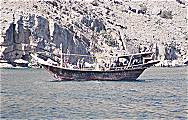 |
|
| Telegraph Island - good snorkeling | Cruising by dhow |
'Round the bend'
The British, in their inimitable fashion, arrived on
this lump of rock called Telegraph Island in the fiords back in the mid-19th century, staying 5 years. They were laying a
telegraph cable from India to Basra in Iraq. Taking the cable
"round the bend" of the Gulf gave rise to the expression, since
living on Telegraph Island in the summer must have sent them crazy.
These days, the island is noted for its rich underwater life. Dhows stop off here to enable tourists to go snorkeling. Take your mask and snorkel with you if possible. These may not always be provided on the dhows.

|
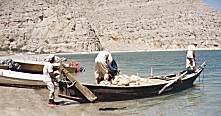
| |
| Hamlets of a 100 people or so lie at the end of fiords, living on fishing. | Putting to sea in a traditional wooden boat. Note the steering oar at the stern. |
Fishing
Fishing is rich. Large species abound, such as
king fish and tuna. All over Oman, you will see fishing for very small
sardines which are spread on the beaches to dry and then used as animal feed.
 |
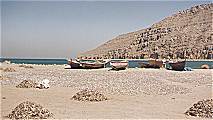 |
|
| Old fishermen | Drying sardines on the beach |
Omani fishermen also ply the tourist dhows. It's a delight to watch the dolphins. Dolphins don't like the speed-boats but will stay close to the dhows, playing "chicken" by crossing repeatedly under the prow as close as they can go, and matching their speed to that of the dhows.
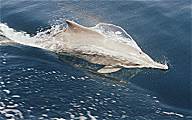 |
 | |
| Dolphins play with the dhows. | The steersman on our dhow. |
Traders from Iran
Khasab makes its money now from the port trade.
Iranians import sheep and goats in small fibre glass hulls with very powerful
engines into the local port, where the animals are shipped off to UAE and
Saudi Arabia in trucks. On the return trip, the sailors load their boats
with electronic goods and American cigarettes.
They have to arrive in Khasab port after sunrise and leave before sunset. We watched as some fifty or so boats gathered outside the port in the late afternoon, taking off together at high speed at some unseen signal. They have to avoid the Iranian coastguard as well as other shipping in the strait waters; the crossing is dangerous with so many oil-tankers passing to and fro. On my return in 2004, they seemed a little more relaxed. I was told that the boatmen can conceal themselves among the numerous small islands in the straits.
Read about this in The Economist archive for 4th April 1999. Another tourist article also appeared in the British Financial Times for 25th March 2000. A Reuters' correspondent visited the area at about the same time but I haven't been able to locate a source for his articles on the web.
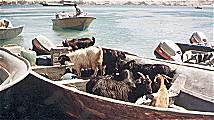 |
 | |
| Iranians bring sheep and goats into Khasab harbour. | They take electronic goods and American cigarettes back with them. |
Diving in Musandam
As well as publicizing the stupendous scenery, tourist developers are working on advertising Musandam as a diving destination. Trips cater for experienced and inexperienced divers alike, as well as snorkellers. Check out this discussion at Dive Forum in January 2004 which concludes that diving in Musandam will attract more experienced divers with an interest in big fish. Visibility is reckoned not to be as good as the Red Sea.
Expert Divers opened a dive centre adjacent to the Golden Tulip-Khasab Hotel in January 2005. This website is in German. Try this one for English contacts. Trips will take experienced divers round the northern edge of the peninsula and offer sheltered diving and snorkeling sites to novices. Several companies operate trips from Dibba on the east coast. Try Al Marsa Charters for example, although I do not know this company myself.
You can cruise the east coast of Musandam in the Charlotte Anne, a 200 ton Baltic trading boat, which was re-fitted with sails in 1994. The schooner is available for charter, both directly from the owners and also from Oryx Offroad, with whom Frederick Forsyth made a trip in 2003, writing it up in the Sunday Times magazine of 25th January 2004.
 |
 |
|
| The Charlotte Anne at anchor in one of the fiords on the east coast of Musandam. Photo courtesy of Chris Hurndall | Bukha Fort, with its round tower, stands by the sea . Bukha used to be the chief town of the province |
Arranging your trip
Khasab
Travel and Tours have offices both in Khasab (+ 968 26730464), and in Dubai, UAE (telephone + 971 4 2669950),
They also have an office in the Golden
Tulip Hotel (+ 968
26730777)
which opened in Khasab in November 2003. The company can pick you up from Dubai Airport and take you by road to Khasab. Certain categories of foreign visitors are eligible for visa on arrival in Dubai. Their visas should enable them to cross into Musandam. The company will ensure that visa arrangements are handled.
KTT offer mountain, dhow, 'city' and diving/cultural tours, as well as apartment accommodation.
 |
 |
|
| The Sindabad, a diving dhow operated by Khasab Travel. | Steep, high cliffs rise from the waters of the fiords |
Odina has written to me to tell me that Musandam Sea Adventure is now offering the same services in Khasab at competitive prices, so you have a choice of companies. Office number is +968 26730069 or mobile +968 99346321. I have not travelled with Musandam Sea Adventure.
The 4 star Golden Tulip Hotel at Khasab has 60 rooms and 12 chalets with splendid views over the Straits of Hormuz. The rooms are spacious and modern. The management offers enticing packages from time to time. If you can endure the heat, summer diving could be a treat.
There's a new hotel now (2008), called Evason Hideaway & Six Senses Spa at Zighy Bay. Unfortunately I'm not quite sure where that is, but photos show a view from a high point overlooking a sandy beach below and the sea. 120 kms from Dubai International Airport and 480 kms from Muscat International Airport. Nice for a quiet getaway perhaps, and spa pampering.
Oman Air flies regularly between UAE (Dubai) and Khasab, and offers very good value package stays of a return flight and two nights at the hotel. Contact Oman Air in Dubai on + 971 4 3518080 / 3521777 or by e-mail.
 |
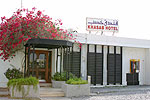 |
|
| The Golden Tulip Khasab hotel stands on the edge of the Straits of Hormuz | The old Khasab Hotel. Business in the bar suffered once the new road was built from Khasab to UAE |
The Khasab Hotel is still open. Basic, but adequate, and cheaper than the Golden Tulip. Telephone + 968 26730267, fax + 968 26730989. Khasab Travel also offer apartments.
The Ras al Khaimah Hilton hotel organizes trips to Khasab according to this press release. Or you can choose the Al Hamra Hotel, also in Ras al Khaimah, UAE.
If you prefer a boat trip, take a look at Oryx Offroad. Al Marsa Charters offers diving, cruising and snorkeling along the east coast of Musandam from Dibba.
Al Marsa Charters (+ 971 6 5441232) have advised me that the best way to reach Dibba is from Dubai. The journey to Dibba by road takes one and a half hours. If you are renting a car at the airport, tell the company that it must have Oman car insurance as well. Providing you meet visa requirements for UAE, you should not need an Omani visa to reach the company's operations in Dibba.
You may be able to rent 4-wheel drive vehicles in Khasab from KTT, providing they are not using the vehicles themselves. You can drive north through United Arab Emirates to the border at Sham in Ras al Khaimah. But, make sure you can meet visa regulations, and have both UAE and Omani car insurance. Many car hire companies in UAE will not be able to offer car hire to cross the border into Oman.
My thanks to Khasab Travel and to the Golden Tulip Hotel for sponsoring my visit to Musandam in March 2004.
References
Musandam: architecture and material culture of a little known region of Oman, Paolo M Costa, 1991, Immel Publishing, ISBN 090715137X. Still available from private booksellers at Amazon.co.uk when last I looked, from the price of £26.25
An index to the papers of Bertram Thomas, who studied the dialect of the Kamazirah of the village of Kumzar. He concluded that their language was a mixture of Arabic and Persian, although distinct from both. He believed that it was primarily a Persian dialect.
Miscellaneous information and links, The Straits of Hormuz
Oman | General | Travel | Visas | Locations | Maps, books | Geology | Snapshots
Bandar Khayran | Jabal Akhdar | Masirah | Mountains | Musandam | Salalah | Seifa | Wadi Mistal | Wahibah
Home | Contact me | Resume | George in Egypt | Oman | Cyprus | Thailand
© Sue Hutton 2000-2008 Disclaimer: information on this page is given in good faith, but is subject to change without notice. Please ensure that you have determined for yourself the prices and availability of any travel arrangements.